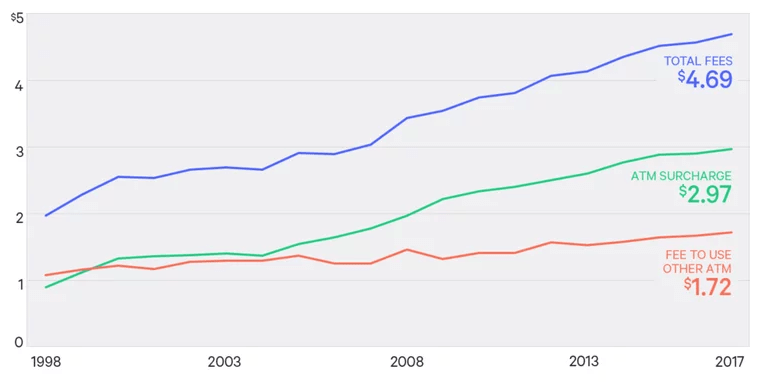ATM Outsourcing: More Opportunities for ATM Owners
The Rise in ATM Outsourcing
ATM outsourcing is nothing new. Financial institutions have been outsourcing ATM services since the 90s. However, the demand for ATM managed services could spike as banks perfect their online banking services and regulations require more ATM updates.

Now, ATM outsourcing is even more attractive in the wake of the EMV update, with another hardware update on the way with the Windows 10 transition. The update costs are significant. And banks are working to consolidate their physical branches, without limiting customer access to banking services.
Additionally, ATM machines aren’t a major source of revenue for most banks. They usually offer free transactions to their customers. So, most of the transactions generate no revenue.
Banks will likely have to eat the cost of the free ATM transactions for their banking customers. But, offloading ATM update costs, maintenance, and ATM vaulting to an ATM managed services provider could easily offset the lost transaction revenue.
And finally, banks don’t want to abandon their ATM services completely. ATM machines shorten bank teller lines and minimize stress on their customer service staff by enabling customers to self-serve for simple transactions.
So, handing the entire ATM operation over to ATM managed service providers is a cost-efficient move for most banks.
This is good news for ATM owners since it means more opportunities to provide white-label ATM solutions in very good locations. However, there are a few things you’ll need to make your services attractive to banks.
ATM Deposits
Most bank branch ATMs accept deposits. Now, the bank may be okay with losing the ability to accept deposits through the ATM machine when they outsource the service. But, that depends on the location and what percentage of the total transactions are deposits.
This means that you’ll be in the best position to scoop up an ATM managed services contract if you have ATM machines capable of accepting deposits and an ATM processor that can communicate with the bank’s system well enough for more than just cash withdrawals.
Banks have historically accepted outsourced ATMs that didn’t accept deposits. However, it’s likely that banks will prefer deposit capable ATM machines in the future as they look for cost-efficient replacements for full-service bank branches. So, accepting deposits will help future-proof your outsourced ATM operations.
Wall-Mount ATM Machines
Standing ATMs are appropriate for some off-site bank ATMs. However, it’s likely that banks will prefer bundled services for their ATM machines. Meaning, they’ll want their ATM managed services provider to supply their branch ATMs in addition to the off-site ATM machines.
Be prepared to offer a wall-mount ATM as part of your package when you’re pitching your services. Branch ATMs are likely to get a lot of traffic, and the bank will be paying the transaction fees. So, supplying a wall-mount ATM machine can be a big win for you.
Updated ATM Machines
You’re probably in the process of updating your hardware to accommodate Windows 10, if you’re already in the ATM business. But, if you want to take advantage of ATM outsourcing opportunities, you may want to speed up the process.
Avoiding update costs is a major reason that banks want to outsource their ATM services. So, it’s pretty much mandatory that you can offer ATM machines that will be compliant past 2020.
Fortunately, most new ATMs will be capable of handling Windows 10. But, future compliance is an important thing to check if you’re purchasing used or refurbished ATM machines.
Either way, the deadline for upgrading ATM machines to Windows 10 will be here sooner than you think. If you want to ride the ATM outsourcing wave, you should concentrate on getting your fleet compliant while banks are still looking for ATM managed service providers to take care of the update for them.
 Service Level Agreements
Service Level Agreements
ATM owners are familiar with these. But, service level agreements are vital when working with banks.
First, the terms of your service level agreement can be a selling point for your ATM services. It removes the risks of ATM outsourcing for the bank and makes your offer more appealing.
But, you’ll most likely need to include things in your service level agreement that meet a bank’s requirements for any ATM, such as armored truck service for ATM vaulting.
Most banks also won’t accept an ATM managed services contract that doesn’t have a service level agreement.
So, if you haven’t developed one yet, you should create a template for your service level agreement. That way you won’t miss anything during your negotiations.
Other Businesses That Need ATMs
While banks may be a major source of ATM outsourcing business, they’re not the only ones who may need ATM machines from an ATM managed services provider.
Many banks have micro branches inside grocery stores, malls, and shopping centers. As banks consolidate their physical locations and move more services to online banking, many of these micro branches will close.
This leaves these locations without an ATM. And, that means opportunities for ATM owners to capture more high traffic locations with dedicated user bases.
So, even though the required ATM updates may present additional expenses for ATM machine owners, they also offer new ATM outsourcing opportunities. And, that’s new business that could more than cover the cost of ATM updates in the long run.


 Service Level Agreements
Service Level Agreements


















